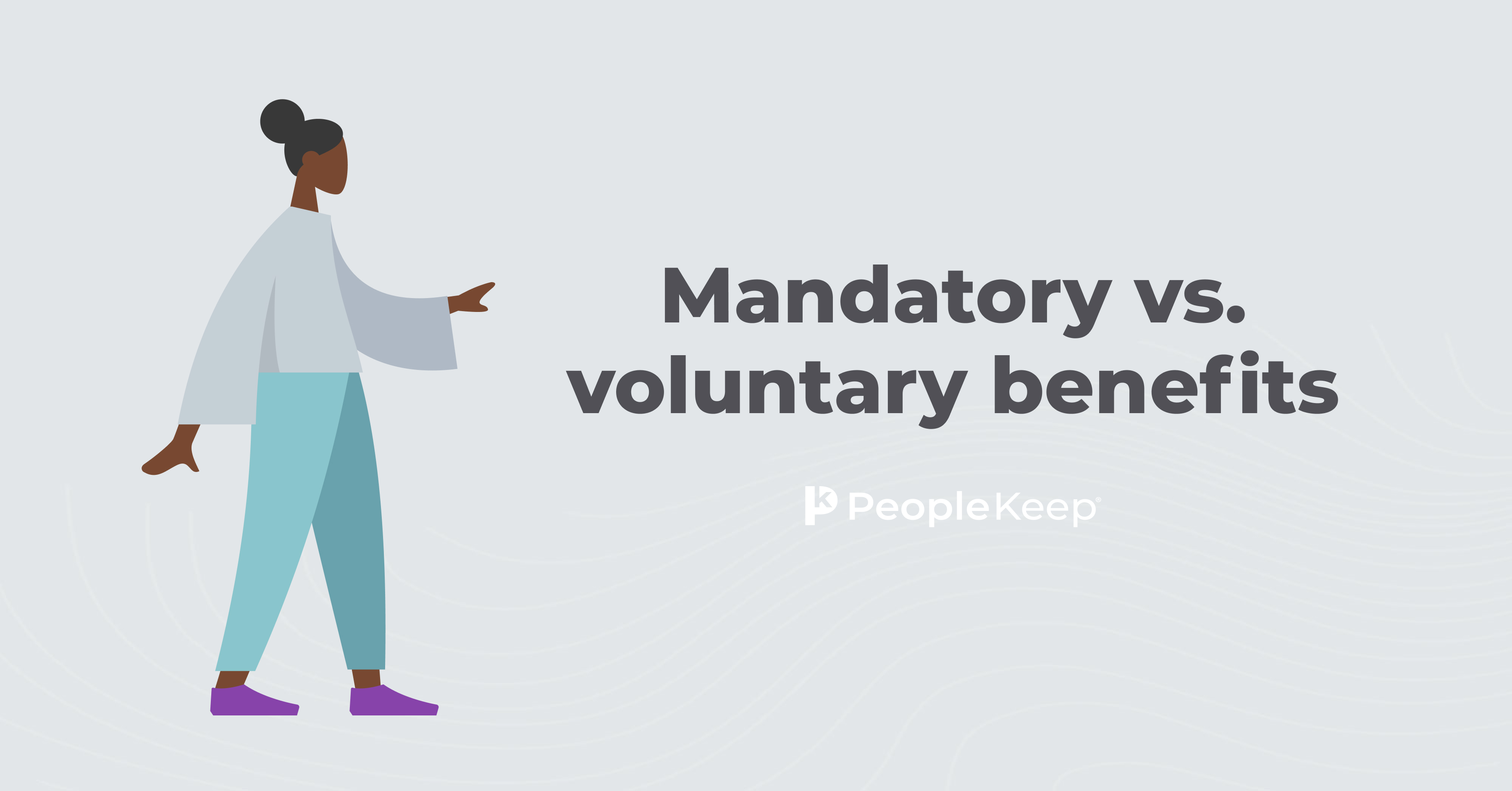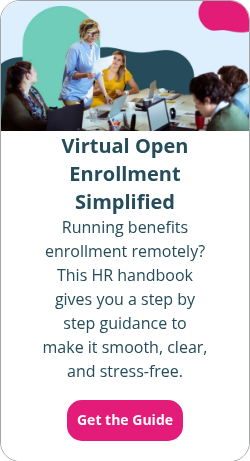How to run a successful virtual open enrollment
By Elizabeth Walker on August 18, 2025 at 8:00 AM
With many organizations being fully remote and employees' growing demand for more flexible work schedules, it’s critical for HR professionals to adapt to this environment and adjust their benefits enrollment strategy.
If most or all of your employees work from home, an in-person benefits fair may no longer be an option when benefits enrollment comes around. Say goodbye to formal benefits presentations, print materials, and an extensive agenda — it’s time for virtual open enrollment!
Virtual enrollment can be exciting because it’s less formal and more flexible. However, for some HR teams, benefits specialists, and small business owners, exploring the unfamiliar territory of virtual benefit offerings can be daunting.
If you’re ready to make the switch but unsure how to proceed, this article has tips and tricks for offering your first virtual open enrollment without a hitch.
In this blog post, you’ll learn:
- How to plan and run a successful virtual open enrollment.
- Ways to select and communicate employee benefits that best match your remote workforce’s needs.
- Tips for engaging employees through digital tools to ensure a smooth enrollment process.
How does open enrollment work?
There are two different types of enrollment for benefits: Open Enrollment for individual health insurance and the annual enrollment period for employer-sponsored group benefits.
Under the Affordable Care Act (ACA), Open Enrollment is the dedicated period for employees to enroll, renew, or change their individual health and ancillary coverage. Having an Open Enrollment Period ensures individuals don’t wait until they get sick to enroll in Marketplace coverage or switch to a more comprehensive plan when they’re about to have an expensive medical procedure.
As of now, the annual enrollment period in most states begins on November 1 and ends on January 15. However, effective starting the 2026 Open Enrollment Period, the dates to enroll in coverage for 2027 will start on November 1 and end on December 15. This applies to all states with public exchanges using the federal Health Insurance Marketplace. State-based health exchanges will also shorten their annual enrollment period to end by December 311.
Outside of the ACA’s Open Enrollment Period for health insurance, many companies have their own enrollment period that employees can use to sign up or change their group health, dental, and vision coverage, life insurance, and other employer-sponsored benefits.
When preparing for their company’s open enrollment period, benefits specialists should carefully review their offering to ensure they’re providing the best perks possible to help recruit and retain talented workers.
Virtual open enrollment is new for many employers and HR professionals. Let’s go over four key steps below to help you implement one for your company.
Step 1: Plan for a virtual open enrollment
The first step in planning your virtual enrollment event is choosing your administration method.
There are typically two ways to administer your group virtual enrollment process:
- Build your own virtual system
- Building your own system means putting more money down initially, but you’ll have the option for greater customization. If you’re an applicable large employer (ALE) looking to offer health benefits, you still must follow all ACA compliance regulations. So you may want to work with a broker to avoid tax penalties if you decide to create your own platform.
- Select an existing HR platform that offers virtual enrollment.
- An off-the-shelf platform requires less financial investment, so it’s the option that makes many small businesses feel more comfortable. Plus, there are usually guarantees or support for any non-compliance from these HR enrollment platforms to better mitigate your risk.
Whichever benefits administration method you choose, using a designated tool can help you eliminate confusion, drive smarter enrollment decision-making, and reduce costs for your employees and your company. A good system should also provide employees with information about plan types, automate the enrollment or re-enrollment process, and ensure compliance.
Lastly, if your organization is only making minor changes to your benefits offerings, you can designate the virtual open enrollment period as passive. This allows your employees’ elections to roll over automatically into the new plan year. But remember, some benefits, like flexible spending accounts (FSAs), require re-enrollment each year as FSA funds don’t roll over.
Step 2: Select the employee benefits you want to offer
The ACA’s Open Enrollment only applies to individual health coverage and Marketplace ancillary coverage. But it’s a good time of year to review your entire compensation package, especially if it’s around the time your company offers enrollment in other benefits and perks. If this is your first time doing virtual open enrollment meetings, surveying your employees is a great place to start.
Asking your employees for feedback on your benefits plan will help you understand what matters most to them. Based on survey results, you can better understand how they feel about your current benefit offerings and what new perks you should add to your compensation package.
There are traditional employee benefits that most industry experts say job seekers expect to see. However, there are also specialty perks that help employers stand out among their competitors.
Below are four popular benefit choices you can consider for your company:
- Healthcare: Consider all health benefit options like traditional group health insurance, health reimbursement arrangements (HRAs), health stipends, and health savings accounts (HSAs).
- Paid time off (PTO) and paid family leave: Companies that provide PTO and family leave have an edge during hiring. These perks allow employees to recharge, so they’re better focused on their work.
- Flexible work hours: Flex hours and schedules — like 9/80 workweeks, hybrid, or remote environments — help employees with young children or elderly parents maintain a good work-life balance.
- Wellness perks: Many employees value their fitness and mental health, and employers benefit from a healthy, active workforce.
Employee benefits are vital to enticing job seekers and satisfying your current staff. However, finding the right mix of benefits can be challenging. It’s never wise to select benefits that your employees don’t want or won’t use. Instead, ask them the types of perks they genuinely value and then look for a benefits vendor that offers cost-effective ways to provide them.
Ready to survey your employees about benefit options? Download our survey template!
Step 3: Communicate virtual open enrollment to your employees
A successful virtual open enrollment only goes so far if you fail to develop a strong benefits communications strategy about the event. Luckily, you can easily educate your employees about your benefits in a virtual environment by using methods like online correspondence, downloadable documents, and other resources.
Email campaigns are a great place to start. But remember to keep your emails brief, so it’s more likely your staff will read all its content. You can also create a one-page PDF “cheat sheet” to highlight important information and give employees helpful tips while enrolling.
A more detailed annual benefits guide is also a great option. If you’ve previously created physical print materials, you simply need to convert them into digital enrollment guides.
Other than email, the following communication options are other tech-savvy ways to advertise open enrollment and benefits updates:
- Text: In today’s world, text open rates average 98% compared to 22% for email2. By using text messaging options, you can better reach all your employees and increase engagement.
- Chat: Create a communication channel on your company messaging system, like Slack or Microsoft Teams, where your HR team and benefits consultants can answer employee questions and concerns.
- Mobile apps: If your benefits administration tool has a mobile app, you can send push notifications to your employees' phones about open enrollment and perk offerings.
Step 4: Provide a benefits webinar or virtual office hours
If you previously kicked off your past enrollment periods with an in-person benefits presentation, modify this for your remote employees by hosting info sessions as virtual events, like through Zoom meetings or Google Meet. Virtual fairs can occur in different forms, such as webinars or office hours.
Here’s how each one can work:
- A virtual benefits webinar is a handy way for HR teams to discuss enrollment basics, deadlines, and new perks. Encourage your employees to attend so they can make more informed decisions during open enrollment.
- Tip: Record these facilitator-led sessions so employees can review them later or if some of your busy staff members can’t attend.
- Virtual one-on-one office hours are an excellent substitute for the personal touch of in-person enrollment with staff members. Employees can get a personalized learning experience about their benefits or ask questions they didn’t want to ask publicly.
- Tip: To ensure valuable time isn’t wasted, notify employees to sign up for pre-determined office hour time slots on your calendar.
Whether you decide on a webinar, office hours, or both, always ask for feedback and leave time for Q&A. If you have significant changes to your benefits package, consider hosting vendor breakout sessions for employees. For example, if you decide to offer mental health counseling, host a separate discussion to explain how individual benefit offerings work.
How PeopleKeep by Remodel Health can help you offer personalized health benefits
Choosing which benefits to offer during open enrollment doesn’t have to be scary. Many benefit solution platforms can help you provide comprehensive employee benefits without the hassle. For example, if you want a compliant and customized health benefit, consider using HRA administration software powered by PeopleKeep by Remodel Health.
PeopleKeep offers much more than a user-friendly interface. We help businesses simplify how they sign up, design, and manage a personalized HRA with ease.
Our award-winning customer support team and user-friendly software keep your employees informed by sending them automated communications, in-app messages, and hosting live chat sessions. We even handle reviewing employee claims, drafting legal plan documents, storing records, and keeping you compliant with federal regulations. With our platform, you can manage your health benefits in just minutes per month.
No matter which one of our three HRA options you choose, PeopleKeep makes it easy for small to mid-sized employers and HR professionals to offer their employees a flexible health benefit that’s just right for them.
Plus, if you offer a stand-alone HRA through PeopleKeep, your employees can shop for individual health coverage right from their PeopleKeep accounts.
Conclusion
Work environments have shifted dramatically in the last few years, meaning HR leaders and employers must make changes to keep up. With virtual open enrollment, HR departments can engage their employees online, reducing their workload and streamlining their benefits while maintaining a thoughtful enrollment experience.
Virtual open enrollment is a great time to introduce new and exciting benefits. With PeopleKeep by Remodel Health, we make offering a personalized health benefit simple by handling administrative tasks and compliance issues on your behalf. Schedule a call with our HRA specialists, and we’ll get you started!
This article was originally published on May 27, 2022. It was last updated on August 18, 2025.
1. Patient Protection and Affordable Care Act; Marketplace Integrity and Affordability
Check out more resources
See these related articles

How to prepare for open enrollment as an employer
Open enrollment season is approaching, and it's important to be prepared. Discover what you need to know before open enrollment with this helpful guide!

Mandatory vs. voluntary benefits
Curious about the difference between mandatory and voluntary benefits? Explore how each type supports employees and boosts your overall benefits package.

How brokers can prepare for open enrollment
Are you preparing for individual health insurance Open Enrollment? Get tips to streamline onboarding and support clients' employees through the process.



